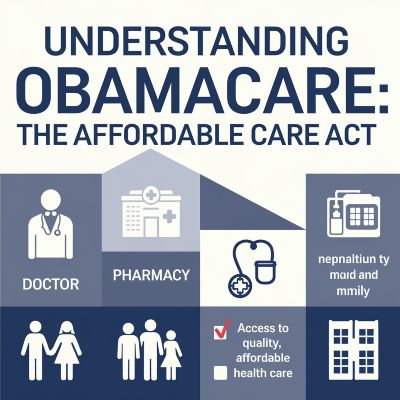Obamacare: What You Need to Know About the Affordable Care Act
The Affordable Care Act (ACA) is a significant departure from how the United States has traditionally approached healthcare. Signed into law on March 23, 2010 by President Barack Obama, it aimed at improving access to healthcare for millions of uninsured Americans and controlling escalating medical costs. This detailed guide will help you comprehend what the Affordable Care Act entails, who is affected and provide information if you are navigating health insurance marketplace or considering Obamacare the Affordable Care Act enrollment.
Origin and Objectives of the Affordable Care Act

The American healthcare system had always faced numerous challenges which led to the introduction of ACA. The situation that existed before its adoption involved millions of Americans being uninsured mainly because they could not afford health insurance or were deemed ineligible due to pre-existing conditions. It was also observed that there was an unsustainable increase in healthcare costs that became a major national problem relating to affordability as well as accessibility.
There were a number of measures that the ACA implemented to address these problems. These were:
- Increasing Medicaid enrollment (Medicaid expansion).
- Designing an online platform where individuals can buy health insurance options.
- Introducing Obamacare subsidies so as to reduce insurance costs.
- Enacting laws against insurers denying pre-existing conditions coverage.
- Requiring every American citizen to have medical coverage or else they pay a fine (this individual mandate was later repealed in 2019).
- The aim of all this was to decrease the number of uninsured Americans, enhance medical outcomes and prevent escalating healthcare expenses.
The Health Insurance Marketplace
One significant innovation that came with the ACA is the establishment of the health insurance marketplace, also referred to as the exchange. This internet portal allows small businesses and individuals to make comparisons before purchasing health insurance plans. The marketplace provides different types of health care options ranging from simple plans with lower premiums but higher out-of-pocket expenses to more comprehensive policies having higher premiums and lower out-of-pocket expenses.
How to maneuver the Health Insurance Marketplace
Many Americans rely on the health insurance marketplace as the main channel for obtaining coverage under ACA. The online marketplace is designed for easy use by featuring a side-by-side comparison of health plans based on price, benefits and choice of doctors. Furthermore, it gives information about whether you qualify for Obamacare premium subsidies that can significantly reduce your premiums.
Types of Marketplace Plans
Marketplace insurance plans are divided into four categories
- Bronze
- Silver
- Gold
- Platinum
The differences among these categories reflect the trade-offs between premium costs and out-of-pocket expenses
Bronze Plans: Lower premiums but higher out-of-pocket costs.
Silver Plans: Moderate premiums and moderate out-of-pocket expenses.(For those with low incomes also qualifies silver plans for additional cost sharing reductions)
Gold Plans: Higher premiums and lower out-of-pocket costs.
Platinum Plans: Highest premiums yet lowest out-out pocket premium.
Your healthcare needs, budget and eligibility for additional subsidies determine the category of plan you choose.
Medicaid Expansion
One cornerstone of ACA was expanding Medicaid an exercise that involved both federal and state governments in providing health coverage to poor individuals and families. The Medicaid expansion aimed at covering all adults with incomes up to 138% of the Federal poverty level as opposed to previous requirements for eligibility.
State Participation in Medicaid Expansion

The ACA initially mandated all states to expand their Medicaid programs. However, a ruling by the Supreme Court in 2012 made it optional. Thus, some states decided against expanding Medicaid leading to a gap in coverage for many low-income individuals who are not eligible for traditional Medicaid but lack means of buying marketplace coverage even with subsidies.
As of 2024, 40 states and the District of Columbia have expanded Medicaid. However,10 states have not deciding on whether or not to expand Medicaid has had far reaching effects on the rate at which people remain uninsured within these States. States that expanded their program witnessed a major drop in the rates of uninsured persons while those that did not continue to experience high numbers without insurance.
Health outcomes resulting from Medicaid Expansion
Medicaid expansion had a positive influence on health outcomes in states that chose to follow suit. Studies have demonstrated that people in the states with expanded Medicaid had better access to preventive care, mental healthcare and management of chronic diseases. Furthermore, increased state Medicaid eligibility has been linked with lowered mortality rates as well as improved financial stability among low-income residents.
Coverage for Pre-existing Conditions
Before the Affordable Care Act (ACA), individuals with preexisting conditions often faced substantial obstacles when it came to purchasing health insurance. Insurers could refuse coverage, charge higher rates or exclude certain ailments thereby preventing many Americans from accessing important medical services.
ACA Protections for Pre-existing Conditions
Under the ACA, insurance companies became prohibited from denying people coverage or charging them more premiums based on their pre-existing conditions. This aspect of ACA is among its most popular ones because it brings relief to millions of previously uninsurable Americans or those who were paying high premiums before.
What is Considered a Pre-existing Condition?

A pre-existing condition is any illness that existed before the beginning of new health insurance plan. They may involve, diabetes, asthma and cancer as well as mental health disorders among others. This has ensured that affordable health insurance coverage is available to everyone through ACA’s protection of people with pre-existing conditions.
High Risk Pools: A Solution Before the ACA
Before Obamacare was enacted, high-risk pools were used by some states to cover people with pre-existing medical conditions. These pools typically had higher premium payments and limited plan options. High risk pools became unnecessary under Obamacare because insurers were mandated to offer coverage to all regardless of their prior medical history.
Obamacare Subsidies
The objective of Affordable Care Act (ACA) was to make healthcare insurance more affordable. Hence it introduced cost sharing reductions and also premium tax credits which are referred to as Obamacare subsidies aimed at lowering premiums and out-of-pocket costs for individuals and families who buy marketplace coverage.
[wptb id=473]
Available Subsidy Types

Obamacare subsidies come in two main forms:
Premium Tax Credits
These are cost reductions on monthly premium payments. The amount of the credit varies according to your revenues and the costs of insurance in your region. Premium tax credits are given to persons or families who have between 100% and 400% of income equal to poverty levels federal.
Cost-Sharing Reductions (CSRs)
Out-of-pocket expenses like deductibles, copayments and coinsurances can be minimized by using this subsidy. CSRs are only available for people who buy Silver plans through the Marketplace and whose income falls within the range of 100% to 250% of federal poverty guidelines.
Qualifying for Obamacare Subsidies
The eligibility standards for Obamacare’s subsidies is dependent upon your household size as well as your household earnings. A calculator that shoppers can use to determine whether they qualify for these grants also exists on the site. When applying for financial help, it is important to figure out exactly what you will earn since changes in income could affect both whether you qualify and how much assistance you receive.
Effect of Health Coverage Subsidies
The availability of subsidies has caused an increase in the number of Americans with health insurance. Almost 90% of those covered by marketplace plans received some form of subsidy in 2023, which reduced the cost and number of uninsured populations.
Individual Mandate and Its Repeal
One of the more controversial parts within ACA was the individual mandate, which required everyone living in America to have a health insurance or pay a fine. The underlying principle behind this provision was to make sure that there is a broad risk pool where both healthy and sick people participate to keep premiums down.
How Individual Mandate Worked
Under this provision, individuals who did not purchase health insurance were charged a penalty in terms of taxes with few exceptions for such cases like financial hardship. The main purpose of this fine was to push healthy persons into buying insurance, so as to balance out the risk pool as well as prevent exorbitant premiums from taking place.
Repeal of the Individual Mandate
The Tax Cuts and Jobs Act of 2017 repealed the individual mandate by reducing the penalties to zero dollars beginning in 2019. Repeal of the individual mandate has triggered a debate about its effects on the health insurance market. Some experts argue that fewer healthy people will buy insurance without the mandate, leading to increased premiums and potentially destabilizing the insurance industry.
Nevertheless, some states have enacted their own individual mandates as a way of ensuring a balanced risk pool and averting increases in premiums.
ACA Benefits: What the Law Offers

The ACA added several essential benefits which every plan sold through marketplaces should cover. These benefits guarantee that everyone is able to have comprehensive care regardless of their health condition or financial situation.
Essential Health Benefits
All marketplace plans must include ten essential health benefits:
Outpatient Care Services: Ambulatory patient services are offered on an outpatient basis without hospital admission being necessary.
Emergency Medical Services: This refers to treatment given for life threatening conditions or severe injuries.
Inpatient Care including Surgery: This category includes medical procedures done when admitted into a hospital.
Maternity and Newborn Care: It covers prenatal, delivery, post natal until child’s first birthday period care.
Mental Health and Substance Use Disorder Services Including Behavioral Health Treatment: It encompasses counseling, psychotherapy “and psychot”.
- Coverage for medications prescribed by a doctor.
- Services to recover lost skills after injury or disability.
- Testing used for diagnosis and treatment.
- This involves screenings, immunizations and routine check-ups.
- Pediatrics services that include dental and vision care for children.
These are important benefits that guarantee every person can retain their health by accessing the needed medical attention while at the same time managing any medical conditions they have.
Free Preventive Services
One of the main benefits of ACA is provision of preventative care services at no extra cost to policyholders.



